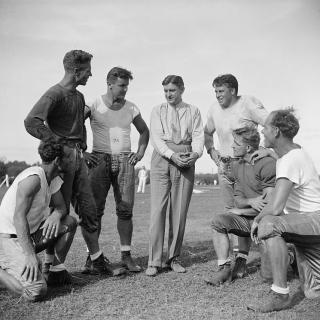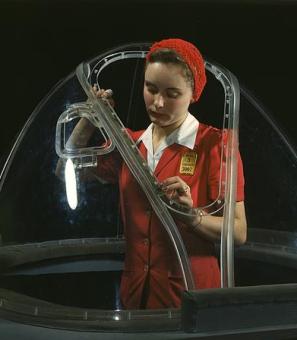1973: The Grateful Dead and the Allman Brothers Mega-Concert
In the summer of 1973, long before bumper stickers of the iconic skeleton-and-roses logo were a familiar sight on camper vans, the Dead teamed up with another legendary rock band, the Allman Brothers, to play a pair of concerts at RFK Stadium that were the first multi-day rock extravaganza in the District's history that drew 80,000 people to witness a rare pairing of southern blues-rock and San Francisco psychedelia. As Rolling Stone reviewer Gordon Fletcher noted: "Every rock & roller on the East Coast worth his or her faded jeans...showed up." It was a show that paved the way for scores of other big stadium concerts and events such as the HFStivals of the 1990s and early 2000s.
Given their strikingly different styles, it might seem the Dead and the Allman Brothers were an unlikely combination. But the two groups had a connection that went back to 1969, when Garcia met guitarist Duane Allman after a Dead concert in Atlanta and jammed with him and other musicians. As Dead bassist Phil Lesh recalled in a memoir, when the Allmans opened for the Dead at the Fillmore East in New York City in February 1970, Garcia recommended that he catch the Allmans' set. "They're kinda like us — two drummers, two guitars, bass and organ, and I hear they jam hard," Garcia told him. Members of the two bands developed a friendship, which continued even after Duane Allman's death in a 1971 motorcycle accident, and over the next few years sometimes showed up to jam at each others' concerts. "We always loved playing with the Allman Brothers," the Dead's rhythm guitarist Bob Weir once explained.
The two bands' managements laid plans in 1972 for them to do a tour together, and even scheduled concerts for the following spring in Athens, GA and Houston. But those were canceled after yet another Allmans member, bassist Berry Oakley, was killed in a motorcycle crash. After the grieving subsided, according to rock historian Alan Paul's book on the Allman Brothers, it was decided that the bands would play a scaled-down tour — a pair of concerts in Washington and another at the Watkins Glen racetrack in New York in the summer of 1973.
Both bands had developed increasingly large followings, and response to the mega concert was enthusiastic. Ticketron, an early computerized ticket vendor, reported at the time that some of the 80,000 fans who purchased tickets came from as far away as Montreal. (The price: Just $7 for each day's show.)
When the horde descended upon Washington, pandemonium ensued. District police made a decision to allow concert-goers to hang out all night in the open area surrounding RFK Stadium — "If 2,000 kids show up and sit on the grass all night, there's not a hell of a lot you can do about it," Lt. Albert Yowell explained to The Washington Post. The bands' fans took him up on that, partying until late and then sleeping in their cars outside the stadium so that they could get to the front of the line. They left mounds of trash and beer bottles in their wake.
According to a lengthy account of the concert by Washington Post reporters Lawrence Feinberg and Tom Zito, things soon got even more chaotic. On the morning of Saturday, June 9, the turnstiles were scheduled to open at noon. But 45 minutes before that, a restless mob of 2,000 tore down a gate, and about half of them forced their way into the stadium before District police were able to blockade the entrance. At that point, stadium officials decided to open all of the gates, and thousands more rushed in to grab seats, which weren't reserved.
With the multitude quickly in place, the party from the night before resumed, as Texas rocker Doug Sahm opened the show. The police had been so overwhelmed by the size of the crowd that they didn't stop them from bringing in coolers full of wine and bottles of liquor. The Post reported that drug dealers roamed through the crowd, selling marijuana and Quaaludes as if they were bags of peanuts. (Because of the latter, "many of the passageways to the grandstands contained youths who were sprawled out on the concrete with their eyes closed," Feinberg and Zito wrote.) One male reveler discarded his clothes and roamed through the stands in the nude. Though he and 17 others were arrested for disorderly conduct, for the most part, "the crowd was peacable," the reporters noted. Those in the first-day crowd of 53,000 who weren't stoned on downers spent much of the time dancing, despite the 90-degree heat.
The bacchanalia grew so frenzied that when Larry Magid, the concert's promoter, climbed atop a brace holding the stage wall in place to survey the crowd around noon, even he was dismayed. "This is no fun!" he told a Post reporter.
Things were equally crazy for the performers. According to Paul's book on the Allman Brothers, the pressure that came with the band's growing fame and success was taking its toll on the musicians. But in Washington, the stress came to a head. The Dead's roadies — who were, as Weir noted, "evangelical about LSD and had no compunction about dosing people" —were slipping it into the food and drinks backstage. The Allman Brothers musicians themselves had been warned beforehand, and kept their hands on their beer cans to cover them, but the band's crew didn't get the word, and some undoubtedly spent the afternoon struggling to work in a hallucinatory haze. Allmans roadie Kim Payne recalled opening a case of cables and freaking out — "they were all moving and looked like snakes," as he later told Paul. At one point, a brawl even broke out between some of the crew and record company executives.
The Dead played first, opening with "Promised Land," and playing songs that included "Deal," "Looks Like Rain," "Jack Straw," "China Cat Sunflower," "He's Gone," "Truckin," and "Sugar Magnolia." (From Dead.net, a fan site, here's the complete set list.) After they finished, the crowd had to wait for four hours before the Allman Brothers took the stage. Bob Weir and Ronnie Montrose, a guitarist who had played with Van Morrison in addition to his own eponymous group, joined the Allmans for "Mountain Jam." (As the Grateful Dead Guide notes, the song was an intriguing connection between the bands; it was based upon a tune by British folk-rocker Donovan, "There is a Mountain," which had also served as an inspiration for the Dead's second studio LP, 1968's Anthem of the Sun.)
As the Post reported, the Allmans — despite the backstage turmoil — "clearly stole the show, with high-power boogie music that had the audience undulating throughout the night."
After the music ended at around midnight, many of the concertgoers lingered around RFK and continued their reveries for a couple of hours, tossing Frisbees and blasting music on tape players and radios, in what the Post likened to "a jamboree of freaks." Eventually, many crawled into their cars to sleep, while others simply bedded down in the parking lot gutters and on the grassy slopes around the stadium. A few even pitched tents, despite the police's intention not to allow that.
The Sunday concert attracted a smaller crowd of about 30,000, who packed the infield, making it "as uncomfortable as a New York subway car during rush hour," according to a Post account by Zito and Megan Rosenfeld. The dancing throng was joined by saffron-robed members of the International Society for Krishna Consciousness, who handed out incense sticks and tried preaching to the intoxicated. At one point in the show, fans scaled two iron scaffoldings in the infield — hanging from them, according to the Post, "like denim monkeys," until police made them get down. The Dead, who this time headlined the show, started out with "Morning Dew" and gave an ultramarathon performance, playing for six hours before concluding with a cover of Chuck Berry's "Johnny B. Goode." (Here's the complete set list.) They got a negative review from Rolling Stone critic Fletcher, who complained that "though they frequently displayed commendable instrumental virtuosity, they suffered from a relative paucity of musical ideas." Even so, he admitted, the hard-core fans who didn't wander off seemed to be enthralled, especially during "Truckin."
Here's a curious relic of the Sunday concert — some silent footage, shot with a Super 8 home movie camera by WFMU DJ Bud Styple.




![Sketch of the mythical fuan by Pearson Scott Foresman. [Source: Wikipedia]](/sites/default/files/styles/crop_320x320/public/2023-10/Goatman_Wikipedia_Faun_2_%28PSF%29.png?h=64a074ff&itok=C9Qh-PE1)












